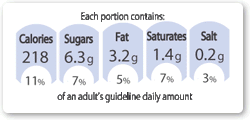The information on this page is historical. Food labels are changing and the term Guideline Daily Amount is being replaced by Reference Intake (RI). Read about the new nutrition labelling requirements.
Ask FDF
What are GDA labels for?
GDA labels show the level of calories, sugars, fat, saturates (saturated fat) and salt contained in a suggested portion of food and, more importantly, tell you what
percentage of your Guideline Daily Amount for calories, sugars, fat, saturates
(saturated fat)
and salt, each portion comprises.
This enables you to build a picture of what you are eating in the context of
your whole diet and make a better informed choice about what you are eating.
GDA icons FAQs
Do you have any information on protein intake guidelines?
The GDA information for protein for an adult woman (45g) and man (55g) and
children (24g) (aged 5-10 years) – for more information view GDAs for different nutrients.
Why do the labels include percentages?
Percentages are included because they quickly and easily clarify the nutritional content of each food product in the context of a person’s whole diet.
This allows you to make informed comparisons between products so you can select
the ones that best suit your needs.
Can you tell me the GDA for sugar for a toddler and a baby? The only guidelines I can find on the site are for a child 5-10 years.
Further details on GDAs for children are available on the Institute of Grocery Distribution (IGD) website. The youngest age band that the IGD set GDAs values for was 4-6 year olds – for
more information view: IGD Best Practice Guidance on the Presentation of Guideline Daily Amounts.
For details of the nutrient requirements of babies/toddlers, the British Nutrition Foundation website is a very useful source of information.
GDA labels FAQs
Working on my own recipe for an organic drink. How do I go about getting the information for the labels?
If you want to know the contents of the drink for the purposes of the back of
pack nutrition table, you will need to get it analysed by a food technologist
like Leatherhead Food International or Campden BRI.
You will need to calculate the nutritional value of your drink per 100ml and
per portion/pack depending how big your bottles are. You can then use our style guide for GDAs as a guideline to develop on your pack a visually consistent GDA front-of-pack
scheme.
Does the 90g of sugar for a women’s GDA include natural sugars?
Women’s GDA of 90g total sugars does include natural sugars from foods such as
fruit, vegetables, dairy products and cereals, and also includes sugars added to
processed foods and drinks.
What are GDA labels for?
GDA labels show the level of calories, sugars, fat, saturates (saturated fat) and salt contained in a suggested portion of food and, more importantly, tell you what
percentage of your Guideline Daily Amount for calories, sugars, fat, saturates
(saturated fat)
and salt, each portion comprises.
This enables you to build a picture of what you are eating in the context of
your whole diet and make a better informed choice about what you are eating.
What is the GDA for adults and children for carbohydrate?
The GDA for carbohydrates for a 5-10 years old child is 220g. Please see this table in this section of our website. The GDAs for the purpose of labelling are for
women.
There is currently a revision of the labelling legislation taking place in
Brussels and it will include GDA values.
GDAs explained FAQs
What does GDA stand for?
GDA stands for Guideline Daily Amount and is the recommended amount of specific
nutrients an adult should consume each day.
Why did the food industry implement GDA labels?
GDAs and nutrition information have been available on the back of packs for
many years.
Therefore, introducing a shorthand version of this information on the front of
packs was a logical step for industry in seeking to make labelling clearer and
more accessible for people.
The use of GDAs on food labels provides an accurate means for people to tell if
a product contains a higher or lower amount of a particular nutrient, compared
to another product. This enables small but positive changes to their diet.
Being able to quickly identify the levels of nutrients in a product also makes it simple for you to focus on the nutrients of interest
to
you, e.g. calories, fat or sugars. Again you can then see more clearly how to
make
simple changes to improve your diet.
More information about Guideline Daily Amounts (GDAs) explained.
Where can I find information about the GDAs for salt, sugar etc?
The GDAs for women, men and children can be found on the following page of our
website: GDAs explained.
Please remember tha GDAs are maximum levels and not targets (apart from fibre);
this means that you should try not to go above those levels.
Last reviewed: 28 Apr 2014

Example of a GDA label
Today’s poll
FSA’s salt campaign uses GDA figures

